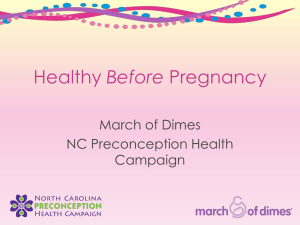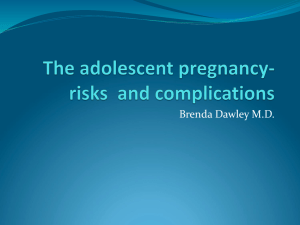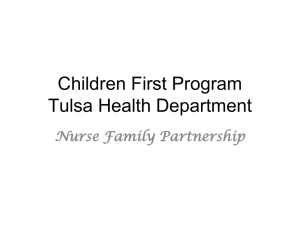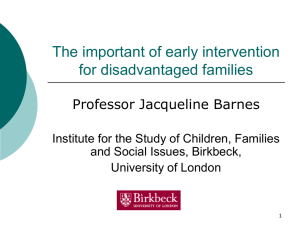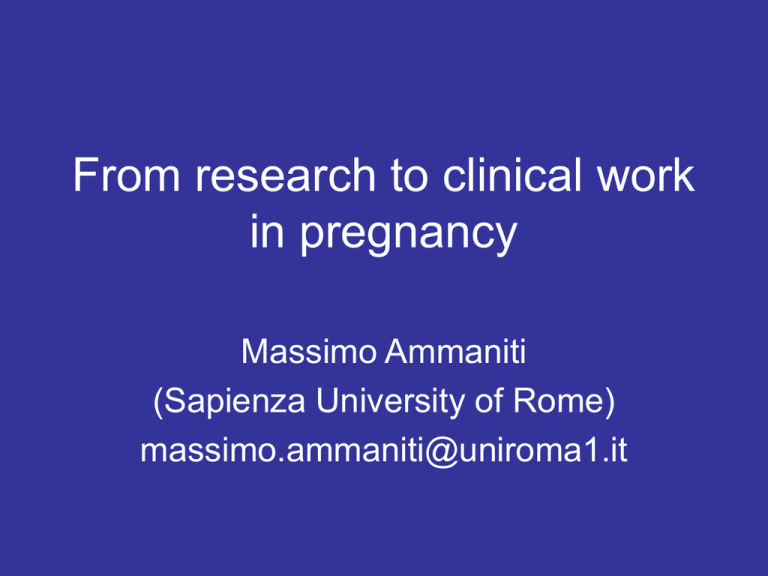
From research to clinical work
in pregnancy
Massimo Ammaniti
(Sapienza University of Rome)
massimo.ammaniti@uniroma1.it
For a woman and for the couple pregnancy is an extremely
important transition phase, during which one prepares to
become a parent and to take care of a child who will be
immature and dependant for all his first year of life. Research
and clinical contributions have lent specific attention to the
construction of the maternal identity, defined by Stern (1995)
maternal constellation, and to the development of maternal
capabilities during pregnancy, which are indicative and
foretelling of the mother-child relationship after birth, even in
at-risk situations.
The psychology and the psychopathology of pregnancy have
been studied using research tools that have addressed
different areas. In this paper we will take into consideration a
few of the more relevant research areas for this phase:
1) The psychological dynamics connected to the
attainment of the maternal identity, analysed through the
mental representations of pregnant women;
2) The formation process of the mother’s attachment to the
child during pregnancy, which prepares the stabilization of
this attachment after birth;
3) Mental states specific to pregnancy, such as the primary
maternal preoccupation (Winnicott, 1956).
The assessment of prenatal parenting has been done through
research instruments with different purposes: semi-structured
clinical interviews, self-report-questionnaires and scales.
1) Semi-structured clinical interviews that investigate the
pregnant woman’s mental representations, focusing
attention to the woman’s past experiences, to how she
copes with pregnancy and maternity and to how she
progressively creates the image of the foetus and of the
future child. To study the mental representations the woman
has of herself as a mother and of the child in a more
systematic way, attention is put on the structure of the
narration the woman does during the interview. The
interview is very susceptible an instrument for exploring
parenting mental representations when they are still not
defined and stabilized.
Among prenatal interviews, the IRMAG-R (Interview for
Maternal Representations during Pregnancy- Revised
Version, Ammaniti et al., 1992-2008) must be noted; this is
a semi-structured interview made of 41 questions which
bring women to tell their experience of pregnancy and of
becoming mothers: their stories are not evaluated by their
content, but on the basis of their narrative structure. The
Interview is performed between the 6th and the 8th month
of pregnancy and is audiotaped and transcribed. The
average length of the Interview is approximately 45 minutes.
The Interview explores the following areas:
I How the mother organizes and communicates her
experience through a narrative structure
II The desire of maternity within the personal and
marital history
III Partner’s and family’s reactions to the news of the
pregnancy
IV Emotions and changes in personal life, in
relationship with the husband/partner and between
the two families occurred during pregnancy
V Impressions, negative and positive emotions,
maternal and paternal representations: space for
internal baby
VI Temporal perspective: expectations for the future
VII Historical perspective with respect to the mother’s
past
The narrative structure of the interview is coded considering
the mother's representation of herself as a mother and her
representation of the child on the basis of seven parameters :
Richness of perception
It refers to the woman’s acknowledgement of herself as a
mother and of the child: this parameter evaluates the way the
episodes, the feelings and the emotions of the woman herself,
of her partner and of the future baby are told.
Openness to change
This parameter evaluates the mother’s flexibility towards
those physical and psychological transformations which are
specific to the experience she is living, referred to herself and
to the future baby. It evaluates the capability of recognising
these physical and psychological changes which involve
herself, her emotional, sexual and relational life as being part
of the process. It evaluates the capability to modify the
representation of the baby as the pregnancy goes along.
Intensity of the involvement
This scale is used to measure the breadth of the woman’s
psychological involvement in confronting experiences
connected to the pregnancy, to the child and to her relation
with the child; this can be found in the description of the
emotional echoes caused by the event as well as in the
woman’s participation to the interview.
Coherence
It measures the story’s coherence, by which the woman,
through a well organised and logical narrative flux gives a
comprehensible picture of herself as a mother, of the child
and of her relation with the child. Coherence is found in the
plausibility of the story told and in the capability to provide
evidence and episodes which sustain her considerations
and her evaluations.
Differentiation
It evaluates the level of the mother’s acknowledgement of
her personal boundaries, of her stable mental and physical
characteristics, of her specific needs and wishes,
differentiated from those of her partner and of her parent
figures. It evaluates the degree to which the mother is
conscious that the child has his own mental and physical
characteristics, with specific boundaries and specific needs.
Social dependence
It evaluates the degree of influence and dependence, to the
limit of subordination, of the woman’s representation of
herself as a mother and of the child from the opinions,
judgements and messages coming from the partner, the
family, friends, the social context, mass media, social and
medical institutions.
It measures the degree of conformism towards others, which can
in extreme cases cause a flatness of representation and a lack of
personal elaboration.
Predominance of fantasies
It is used to measure the emerging of fantasies regarding the
pregnancy, her future motherhood and the representation of the
child, intended as all those images, metaphors, analogies, openeye and night dreams, expectations, fears and wishes which
characterise the way a woman imagines the pregnancy
experience and the representation of herself as a mother and of
the child. The fantasies can refer to the pregnancy itself, to the
woman’s body, to delivery, to rearing, to the integrity and physical
health of the baby, its physical and character qualities, to the
mother’s role; these can all have a more or less realistic quality.
It is not only the number of fantasies which must be considered
in assigning the score but their importance and their impact on
the representation of the mother and the child.
These seven parameters all refer to the woman’s representation
of herself as a mother and to her representation of the child and
are codified in scales with a five-point range (from 1 to 5). The
assignment of the final score individuates three different styles
of maternal representation:
Integrated/Balanced
The integrated/balanced maternal representations are coherent
narrations, in which the description of the experience the woman
is living is rich in episodes, moods, and has an intense
emotional involvement in an atmosphere of flexibility and
openness towards the physical, psychological and emotional
transformations the mother is confronting. The relationship with
the child is already present during the pregnancy, and the child
is considered as a person with his own motives and moods.
Integrated/Balanced Mothers
Martina’s story is a perfect example of an Integrated Mother
model . In her answers, we feel the importance she gives to
her pregnancy on which she has concentrated all her forces.
A great capability of recognising her mental states as well as
her husband’s emerges from her words, as if she is used to
examining herself and the people who surround her.
Q – Would you tell me about your pregnancy?
A – This was a desired pregnancy, completely, even
because I’m more than 30 years old. I was once married,
then separated and now I live with this new man who gives
me great tranquillity. I have always wanted a child, so I
thought I had to have it now or decide I’d have a life without
children. So I did all the tests, a year before, I got prepared;
it definitely was a planned pregnancy. When I became
pregnant, I had just switched to a new job, since I was
planning to have a child I had switched from a full-time to a
part-time job. I have many interests, I do artistic gymnastics
and many other things; I don’t believe you have to quit
everything when you have a baby. Of course you will be
dedicating most of your time to the baby, but you have to
keep doing your own things.
Q – How did you face this pregnancy?
A – I had some problems, from a physical point of view.
Psychologically I faced it very well. Of course you are a bit
shocked, I think that happens to everyone because there’s
something new, something you don’t quite understand,
especially when you have your first ultrasonography, when
it’s still tiny, you see this little spider. And then this child is
growing inside of you. It kicks you, and you feel something
weird and think “Oh God, there’s a baby growing inside of
me”. I know it’s not really strange but it just surprises you.
I actually accepted it from the start; I wanted a child so
much; of course it’s also important that the man I live with
now gives me such tranquillity.
Q – Would you tell me how you felt when you first found out
you were pregnant?
A – When I first found out, because of the practical problems
with my job I wasn’t actually sure if I should be happy or not.
Then I thought that everything could be arranged, because
even when confronting problems of schedules, of work, when
you know you’re going to have a baby it all becomes relative
before the baby.
At first you’re a bit surprised, even because they tell you you’re
pregnant but you can’t feel it yet. You feel as usual, normal, at
least until you start growing a belly.
Q – Who else did you tell?
A – My mother, my father, my cousin
Q – All the same day?
A – Yes, the same day. I called my mother that evening. I
wasn’t sure if I should tell her immediately, or how to tell her, if
in person. Then I just called.
Q – When did you notice the first changes in your body?
A – Everybody asks that. In the first few months, only around
the fourth month when the belly starts becoming noticeable. At
that stage, when it’s still small. You actually feel as if you are
only overweight and you feel ugly. Now that I have a big belly,
I have no problems: if I pass before a mirror I see it.
Q – Have there been specific moments of great emotion
during the pregnancy, until now?
A – Some times I feel very sad; I don’t know if this is normal,
or connected to the pregnancy. For example I am more easily
upset and seem to feel things more intensely.
Q – Do you have specific fears?
A – I’m afraid the baby might have some problems, defects,
but it’s not a great fear; I’m actually convinced I will deliver a
beautiful girl. I don’t know why, but I’m convinced.
Q – Have you had dreams related to the pregnancy?
A – One dream I remember, because it was only a couple of
nights ago, I was losing blood from my mouth, I don’t know
why. In general when I dream I see myself pregnant, yes, I’m
always pregnant in my dreams now, even if I don’t
remember them clearly.
Q – When you realised there was a baby girl inside of you
what did you feel?
A – As I said before, a lot of amazement. And in this period, I
feel very creative. Alessandro said: “Of course, this is the most
creative of periods!” And I answered “Actually, if you think
about it, you and I have created a girl, created her from
scratch, because before there was nothing.”
(Zero)
Q – And the awareness of this new being came with her first
movements?
A – With the first movements, yes, but even more in this last
month. I really feel her, I feel she’s in here.
Q – What do you imagine her like?
A – Beautiful. I imagine her beautiful. And then obviously she
sleeps. She has to sleep for months. And then I imagine her
calm, friendly and always smiling.
Q – And physically?
A – I imagine her tall, skinny. And blond with blue eyes.
Simply beautiful.
Q – Would you say that there already is a relationship
between you and the baby?
A – I don’t know. I sing lullabies to her, inventing them. I talk
to her, simple things like “How are you?”. I talk to her in my
head more than with my voice. In the morning I tell her “Now I
will sing a lullaby for you, calm down”.
Q – Have you chosen a name?
A – Yes, we will call her Chiara. It’s not a family name, we
just chose it from the start. It’s nice, it’s a name we like.
Q – What do you think she will need in the first months?
A – Most of all love, lots of love, attention, in the first
months especially. She needs to feel in a warm
atmosphere, full of care, where she is taken care of,
welcomed.
Q – What kind of mother do you think you will be in the first
months?
A – In the first months I would like to be tolerant, open. I
hope to be very stimulating for the baby, and very caring.
Q – What kind of mother you don’t want to be?
A – I don’t want to be obsessive, anxious, authoritarian in
a bad sense.
Restricted/Disinvested
The restricted/disinvested representations emerge from
narratives in which a strong emotional control prevails, with
mechanisms of rationalisation towards the fact of becoming a
mother and towards the child: these women talk of their
pregnancy, of motherhood and of the child in poor terms,
without many references to emotional events and changes.
The storytelling has an impersonal quality, is frequently
abstract and does not communicate emotions or specific
images .
Restricted/Disinvested Mothers
Flaminia is a young woman who shows a restricted
representation of herself as a mother and of her
child. Even though she gives value to her
motherhood experience, Flaminia wants to maintain
her independence and self control and does not want
to be too conditioned by the child that is about to be
born.
Q – Would you tell me about your pregnancy?
A – I must say I was very lucky, I never had any problems.
Even in the first three months, I had no nausea, vomiting etc. I
did some things which you’re supposed to avoid, like skiing,
going on a motorcycle… but I felt ok, felt I could do it. But my
first three months were characterised by a certain
nervousness, a state of tension. After the first three months I
started getting used to the idea and calmed down. I still had
no physical problems. Then slowly, with great difficulty, I
started getting used to the idea of my body transforming.
Q – Why a baby in this moment of your life?
A – I thought about it a lot because I didn’t feel ready, even if
I’m not a kid anymore. I always had this idea I wouldn’t have
kids. I’m not crazy about kids, I’ve never been drawn to them
much. Then, maybe because you feel the need after a
number of years in a marriage, or maybe because my
husband who wasn’t convinced either, changed his mind… it
was a series of things which pushed me towards this
decision.
Q – What did you feel when you found out you were
pregnant?
A – I am quite cold, as a person. I don’t get carried away
easily, so even in this case I wouldn’t have told anyone, I’d
have kept it for myself. I first needed to get used to the idea.
Q – Have there been specific moments of great emotion
during the pregnancy, until now?
A – Maybe when I did the ultrasonography towards the fourth
month. That’s the first time you actually see this little growing
being and you see it whole. But mostly my feeling was a
reflection of the great emotion I could see on my husband’s
face. Seeing his reaction, I let myself be influenced by his
state of mind mood and felt it as if it were a feeling of mine.
Q – During the pregnancy, were there times when you felt
worried or mad about something? Have you ever felt any
particular needs?
A – I can’t think of anything now. The preoccupation
everyone has, on the baby’s health.
Q – Have you had dreams during the pregnancy?
A – Yes, but I never remember my dreams. I remember I was
eating yoghurt in the last one, but I have no idea what it might
mean.
Q – How do you imagine the baby?
A – I actually don’t imagine it.
Q – Do you imagine its physical features, its character?
A – No.
Q – And its sex?
A – Not even its sex, I didn’t want to know and I don’t want to
think about it. It will be a surprise.
Q – Do you and your husband talk to the baby or use nick
names?
A – Yes, but it’s mostly my husband who talks to it, not me.
Even if I feel there is a bond between the baby and me, I
still can’t bring myself to talk to it.
Not integrated/Ambivalent
The not integrated/ambivalent maternal representations
are those found in confused narrations, characterised by
digressions and by the woman’s difficulty in answering
questions in a clear and articulate way. The coherence of the
story is poor, and an ambivalent involvement of the mother
towards the experience she is living, towards her partner and
towards her family is present. These women often express
contrasting attitudes towards their motherhood, or towards the
child. The son or daughter is frequently awaited to satisfy the
caregiver’s needs.
Not Integrated/Ambivalent Mothers
Roberta is an example of Not Integrated Mother. A young
woman of twenty-nine years old, the idea of having a child has
made its way in her amidst many ambivalences and
uncertainties, showing all the difficulties that a not integrated
mother manifests in fully accepting a maternal identity.
Q – Would you tell me about your pregnancy?
A – In the beginning we had many things, those egoistic
projects of settling everything first, because we started out
with nothing, and we thought ‘we’ll think about a baby later
on. So let’s say it wasn’t a thought, like we both had of
the baby in the beginning. Then when things started
working out, everything, we looked each other in the eye
and said ‘what do you think about it? I am thirty already’.
And he didn’t want to, he had decided that he was already
old when we married; he had already settled, so he had
some difficulties, he said he didn’t want to be a
grandfather. (…) He had these problems, fears, which I
didn’t have, mine were completely different, like how will I
help my child in 20 years time, finding a job, or school for
example.
Now I’m completely terrified on how to do things, and the
kinder garden, the people he will hang out with cause we
know what it’s like, and my mentality is not ‘live by the day’,
maybe I worry too much about everything around me.
That’s why I used to say ‘let’s wait’ then one fine day this
decision just arrived. ‘What do you think about it?’ ‘And maybe
yes, it’s time’, we made a joke about it, ‘Time to take on
responsibilities...’ That’s when I started thinking, I started
asking around, how many children, how long did it take etc.
Someone told me ‘I thought about having the first one for four
years and then the second in twenty day’; others go:
‘Immediately, one after the other’. These kind of things. I said
‘O God, I waited so long, and now I’m thirty’, in fact this was
my fear, I said ‘You’ll see that now that I want one, it won’t
come’.
(…)
I looked for a laboratory where they could do my, my urine
test and so I did it, and she goes ‘Congratulations’ and I was
practically walking trying to avoid holes, absurd, because I
had taken two buses to get there, and I was walking as if over
boxes of eggs, I was afraid of ruining this thing.
I thought ‘Oh my God maybe I did something in the first days.
(…)
In the beginning, after a month and a half, I started having
nausea problems, upset stomach, lots of saliva, so that after
two months I was thinking ‘Why on earth did I do it?’.
Because I was really sick. (…) I was thinking ‘What a terrible
pregnancy I’m going to have’ because some would say ‘It’s all
going to end soon’ and others ‘I threw up all the way to the
ninth month’.
(…)
And my doctor said ‘it’s mostly psychological’. On one hand
we wanted it, but on the other maybe there was a part of
truth, because I was very embarrassed to tell my boss, I
didn’t know how to tell him.
Q – How did you feel when you found out you were
pregnant?
A – I found out after only a week, and there I was, telling the
nurse ‘Are you really sure?’, because maybe it could be like
with those pharmacy tests, which are uncertain. They told
me in the pharmacy that if it’s sure, when it appears clearly
it’s positive, that is, it’s negative; no, no it’s positive, when it
appears clearly; when it’s uncertain it could be positive or
negative. I was so excited because it’s not… I was saying
‘No, it’s not possible’, in that moment it wasn’t ready. (…)
In the laboratory, he said “Look, the stick doesn’t become
pink if it’s not positive”; so nothing, this thing was pink,
‘if you say so it must be, you guarantee, when I walk
out of here I can tell my husband’.
Q – How did you feel and how did your life change during
pregnancy?
A – How did I feel? Happy, really happy personally, and all
the people around me where happy, so it was really nice;
except for my boss, maybe, because probably for him it
wasn’t. But aside from that, even with the people we know, I
found people very happy to give me some advice, things like
don’t do this, or that. Don’t gain too much wait or eat all you
can cause it’s for the baby, everyone. Younger people will
say ‘Don’t eat too much, you’ll get fat’ and older people will
say ‘Eat a lot so you have a big healthy baby’, clearly not.
Q – Have there been specific moments of great emotion
during the pregnancy?
A – Yes, when I did my ultrasonography in the fourth month,
when they said ‘this is the heart beating’ and on the screen
monitor there was this confused image, but when we saw the
head, I absolutely didn’t imagine that I could see a profile. It
really gave me a strange impression, seeing it.
(…)
Then there’s this thing which doesn’t excite me but amuses
me. I have found out that, in the morning, drinking very hot
milk, the baby does some strange movements. And I feel them
even when I drink cold water, directly out of the fridge; so
sometimes I switch from a hot thing to a cold thing to see what
reactions it has.
Q – Are there dreams you remember of this pregnancy
period?
A – Yes, I realise I have been dreaming more, but mostly it’s
bad dreams. Sometimes sad dreams, sometimes bad ones,
really bad.
Q – What did you feel when you first realised there was a
baby inside you, ?
A – Happy, because I thought ‘it’s there, so I have to be
careful of what I do, to do things to not… The first period for
example I was very anxious and I had terrible pains in the
stomach and I was afraid the baby felt pain too.
Q – How do you imagine this baby?
A – Wishing is different from imagining. How I imagine it, I
don’t know, I imagine the baby ugly and dark, with dark hair;
how I wish it to be instead is different, obviously beautiful and
with clear eyes, beautiful; well, I’d like one thing, one wish,
that it doesn’t look like me.
Q – Do you imagine the baby as a boy or a girl?
A – I imagine it as a boy but I hope it’s a girl.
Two independent, trained, certified, and reliable judges code
IRMAG interviews according to the above described seven
rating scales. Inter-rater reliability for IRMAG scales ranged
from .89 (coherence) to .96 (predominance of fantasies ),
with a mean reliability of .92. Inter-rater reliability with
respect to the main category was 94% (k=.83, p<.001).
Disagreement was solved by a third rater.
Statistical validity is supported by an exploratory factor
analysis using oblimin rotation, performed both for
maternal representation of herself as a mother and of
her child.
Considering the statistical characteristics of the Interview the
screen plot suggested that two factors should be extracted,
in both cases. The two dimensions formulated to define the
construct of mother's mental representations of herself as a
mother were confirmed by factor analysis and accounted for
70.50% of the post-rotational variance. Measures of internal
consistency (Cronbach’s alpha) were conducted to examine
the reliability of the two dimensions (F1, M=2.99, SD .40, α
.85; F2, M=2.61, SD .58, α .52 ).
In the same manner, the two dimensions formulated to define
the construct of the mother's mental representations of her
unborn infant were confirmed by factor analysis and
accounted for 78.95% of the post-rotational variance.
Measures of internal consistency (Cronbach’s alpha) were
conducted to examine the reliability of the two dimensions
((F1, M=2.89, SD .40, α .93; F2, M=2.63, SD .73, α .45 ).
At the end of the interview the are 5 scales modelled on
semantic differentials, each containing 17 pairs of opposite
adjectives. The first three scales designate the individual
characteristics of the unborn infant, of the woman’s self and
of the infant’s father. Comparing the three lists, it is possible
to evaluate if the representation of the baby is more
influenced by the woman’s self-representation or that of her
partner.
The other two scales, deal with the maternal characteristics
of the pregnant woman and those of her mother. In this
case adjectives will refer to affective orientations, personal
lay-out, maternal role, maternal sensitivity and competence.
The interview is used to assess how information and
emotions concerning the woman herself and her child are
organized, whereas the five scales give us a picture of the
contents of the representations. The two instruments can be
used together (Ammaniti et al. 1992; Ilicali, Fisek, 2004)
and independently (Ammaniti, Tambelli, Perucchini, 1998;
Pajulo et al. 2001; 2006).
To explore the configuration of paternal representations and
their differences from the mother’s the I.R.PA.G. (Interview
for Paternal Representations during Pregnancy-Ammaniti,
Tambelli, Odorisio 2006) is used.
As indicated in table 1, fathers’ representations have a
different distribution confronted with mothers’ ones.
Tab. 1 Distribution of Maternal and Paternal Representations
during Pregnancy (IRMAG/IRPAG)
Group
Integrated
Ambivalent
Restricted
Mothers
(N=162)
89 (54,9%) 35 (21,6%)
38 (23,5%)
Fathers
(N=162)
93 (57,4%) 15 (9,2%)
54 (33,4%)
• hi2(2, N=324)= 10,87 g.di l.=2 p= 0.004.
The results reported in tab 1 show that in our sample the
integrated/balanced parental representation is equally
distributed among women and men, as opposed to the
restricted/disinvested one more common among men and
the non integrated/ambivalent one more common among
women. These data confirm the differences of
psychological orientation of mothers and fathers during
pregnancy, even though the mothers’ and fathers’ attitudes
draw closer after birth.
The use of IRMAG-R in at-risk pregnancies allows to study
the contents and structure of maternal representations
which give significant indication to evaluate parenting
capabilities during pregnancy and the postnatal period.
Tab. 2 Distribution of Maternal Representations during
pregnancy in risk and non-risk mothers
Group
Integrated
Ambivalent
Restricted
Normal
mothers
(N=239)
60,7%
(145)
20,1% (48)
19,2% (46)
Risk
mothers
(N=132)
43,2% (57) 34,1% (45) 22,7% (30)
• hi2(2, N=371)= 11,93 g.di l.=2
p< 0.003.
In at-risk situations, persistent preoccupations and phobic
fears have been found; a specific scale is being created for
these. This scale allows us to detect the levels of
pervasiveness and intrusiveness of fears in relation to the
pregnancy, to delivery and to the rearing of the child. The
scale for the evaluation of the risk factors is, like the others,
an ordinal scale with a five point range.
The IRMAG-R can be used for research in the clinical field
to study the psychological state of women during pregnancy
or for at-risk situations, in medically assisted pregnancies or
in projects to support motherhood.
2) Self-Report Questionnaires and Scales have been used
to assess attachment processes during pregnancy, when
emotional ties start rising between mother and child. The
construct of prenatal attachment (Cranley, 1981; Condon,
1993; Muller, 1993) takes account of the mother’s affective
investment for the foetus, which is “the most precocious and
basic form of human intimacy” (Condon & Corkindale, 1997,
1998). Condon (1993) has suggested a hierarchical model
of attachment based on five subjective experiences which
derive from maternal love experience and mediate this core
experience and overt behaviours. These subjective
experiences are expressed in maternal disposition "to know"
the loved foetus, "to be with" him or her, "to avoid separation
or loss" of the loved object, disposition "to protect" the
foetus and finally "to gratify" the foetus's needs.
The quality and evolution of the prenatal attachment is
influenced by many factors, first of all by the advancing of the
pregnancy which entails growing ties between the mother
and child, hastened by the appearance of foetal movements.
Aside these factors, the personal history of the woman and of
the couple have a significant influence on prenatal
attachment.
Obviously this attachment is not only present in mothers but
in fathers as well, although in 15-20% of the fathers this
affective attachment to the foetus seems not to rise
(Condon,1993).
The instruments more frequently used to study prenatal
attachment are Self-Report Questionaires.
Maternal Fetal Attachment Scale (MFAS) (Cranley, 1981),
based on 24 items upon which an agreement score from a
range of 5 points is expressed. Higher the score in the items
and more definite and consistent is the mother’s attachment
to the foetus. The items refer to 5 basic components:
differentiation of self from foetus, interaction with foetus,
attributing characteristics to the foetus, giving of self, role
taking. Measurements of internal consistency (Cronbach’s
alpha .85) are good on the total of the items, while the
subscales have lower scores (between 52 and 73). Typical
of the MFAS is that the items evaluate the mother’s
behaviour more than her feelings or thoughts. In the
validation sample used by Cranley, this instrument was used
between the 35th and 40th week. The scale of maternal
attachment was later adapted to a specular version which
measures the father’s attachment to the foetus.
Maternal Antenatal Attachment Scale (MAAS) (Condon,
1993), based on 19 items, the response is rated on a 5
response options, enquiring as to the frequency and /or
intensity of these experiences over the preceding 2 weeks.
The scale was used during the third trimester of pregnancy
and has good levels of internal consistency (Cronbach’s
alpha >.80).
It measures, beside a global attachment value, two
underlying dimensions: quality of involvement and intensity
of preoccupation. From the characteristics of these two
factors, four styles of attachment can be identified: positivepreoccupied, positive-disinterested, negative-preoccupied,
negative-disinterested. The fathers’ version is based on 16
items, 14 of which are in common with the mother’s, as
Condon sustains that prenatal attachment, even though it has
a common basis for mothers and fathers, has specific
aspects as well.
Prenatal Attachment Inventory (PAI) (Muller, 1993). The
inventory is based on 21 items. The response to each item is
rated on a 4-point Likert scale. The higher score indicates
greater attachment. In structure it is similar to Cranley’s scale
but the aspects explored are different. It refers to attachment
theory, describing women’s thoughts, feelings and relationship
towards the foetus. Two constructs, in particular, are
extremely relevant in the theoretic model at the basis of the
PAI: attachment relation to the partner and adaptation to
pregnancy, because according to Muller (1993) these are both
positively related to prenatal attachment. The statistical
analyses have shown good validity and internal consistency
(Cronbach’s alpha varies from 81 to 91 in all researches that
used it). Muller’s instrument does not allow an evaluation of
father’s prenatal attachment.
The measurements from the self-evaluation scales
described above concern the quality and quantity of the
emotional investment of the parents towards the foetus
without, however, going into more complex elements
(mental representations of the parents, parents’
attachment models). Therefore these scales can be used
together with other research instruments.
3) Inventories have been used to study the psychic state
during pregnancy, such as the primary maternal
preoccupation, a mental state Winnicott (1956) described as
“almost an illness” that a mother must experience and
recover in order to create and sustain an environment that
can meet the physical and psychobiological needs of her
infant. He hypothesised that this special state begins towards
the end of the pregnancy and continues through the first
months of the infant’s life.
If Winnicott’s concept had a clinical sense, it was later
explored by means of a semi-structured interview, Yale
Inventory of Parental Thoughts and Action,YIPTA
(Leckman et al., 1999) within which an Inventory
systematically explores the mother’s and father’s
preoccupations and thoughts.
The specific content of the YIPTA covered the thoughts and
actions associated with three domains of caregiving (Care),
relationship building (Relationship) and anxious intrusive
thoughts and harm avoidant behaviours
experienced/performed by parents (AITHAB).
The YIPTA is designed for the use of experienced clinicians
and has been used at the eighth months of gestation, at two
weeks after delivery and three months after birth.
The measurements of the Early Parental Preoccupations and
Behaviours, besides outlining the psychic states typical of
mothers, highlight depression and anxiety symptoms that can
appear during pregnancy, while the AITHAB measurements
highlight intrusive thoughts and harm avoidant behaviours
which are conceptually related to obsessive-compulsive
disorders (OCD). It can be hypothesised that some forms of
OCD that appear in this period are the dysregulative result of
this specific psychic state that appears during pregnancy.
Both parents present the highest levels of “preoccupation”
towards their child around birth time (between the eighth
month of pregnancy and the second week after delivery).
Thoughts about the baby during the period of Winnicott’s
primary maternal preoccupation occupy the minds of the
mothers and fathers for respectively 14 and 7 hours a day.
At the eighth month of pregnancy (Leckman et al., 1999) the
following has been found: preoccupations on the baby’s
health in 95% of the mothers and 80% of the fathers (health,
growth, aspect), thoughts of damaging the baby in 37% of
the parents (making it cry, shaking or hitting it, dropping it).
These thoughts are a reason of personal distress in 20% of
the cases.
The progress of thoughts and preoccupations shows that
these tend to appear around the eighth month of pregnancy
and reach their climax around the second month after birth
to then slowly disappear. (fig.1).
The YIPTA permits an evaluation of the level of parental
preoccupation which is an important psychic state during
pregnancy and the postnatal period because it focuses the
parents’ attention on the baby’s health and stimulates
better caregiving capabilities. In the mother’s depression
and in obsessive-compulsive states the level of
preoccupations can occupy the mother’s mind completely
and interfere with her maternal capabilities.
Intensity of
preoccupations for the
child
Figure 1
Trend of parental preoccupation during pregnancy and
post-natal period
(From Leckman et al.,1999 modified)
Mothers
Fathers
8th month
1st month af ter birth
2nd month
3rd month
Clinical implications
• Desire of motherhood and of pregnancy (Pines, 1972).
This element has important implications for adolescent
pregnancies, in which a narcissistic attitude is in the
foreground.
To this purpose it is important to notice how the news of the
pregnancy was received and how it was (or wasn’t)
communicated to the family.
• The pregnancy takes on a different meaning depending on
the personal history of the woman, on her experience of
attachment as a child, on her adolescence dynamics, on her
relationship within the couple and especially of her
relationship with her mother.
Our research (Ammaniti et al., 1995) has outlined three
different
maternal
styles
(integrated/balanced,
restricted/disinvested,
preoccupied/ambivalent)
that
correspond to observations in the clinical field (Raphael-Leff,
1993) which have drawn attention to different configurations:
facilitator, regulator and reciprocator mothers.
Our researches point out that these psychic maternal
configurations do not overlap with attachment models which
on the contrary are relatively stable. These maternal
configurations are influenced by pregnancy psychological
dynamics, that is by the maternal constellation (Stern, 1995)
within which a motivational system based on caregiving and
on the child’s protection is activated. As stated by Stern, the
pregnant woman tends to rely on other women who have had
children and have gone through the motherhood experience.
• From this point of view, the relationship with one’s own
mother represents the most significant relational area
because a woman facing pregnancy is undergoing a great
transformation: from woman she is becoming a mother, and
this is possible only if she is authorised and sustained by her
mother, who is her identification model.
In clinical situations, this relationship can become particularly
conflicting, as a competitive dynamics of depreciation is
established and feelings of jealousy, envy and refusal are
cast upon the mother figure.
Often in pregnancy, the woman has a tendency to idealise
her maternal capabilities and to defensively depreciate her
own mother; regarding this, the birth of a child can help the
elaboration of the ambivalence and stimulate a more
adequate identification with one’s own mother.
• An important area is the woman’s representation of the
child she bears. In most cases, the child is given personal
features, a nickname, he is attributed intentions, motives and
can even be considered a partner for conversations.
In other situations, in the detached mothers for example, the
child is considered a foetus, not a person yet and is not
represented with personal features and characteristics.
In at-risk situations, the child can be perceived as a danger, a
threat for the mother’s autonomy, a dependent presence,
even a parasite (Ferenczi, 1941).
• Regarding the area of preoccupations and fears, these can
appear during the last phases of pregnancy which are
directed to a psychological focusing on the child (primary
maternal preoccupation, Winnicott, 1956).
However, it is in this phase that psychopathological shifting
towards obsessive-compulsive disorders can reactivate or
appears for the first time.
In the primary maternal preoccupation, the persistent ideas
are similar to obsessive ideas, so is the avoidance of certain
ideas such as hurting the baby and the need to verify
everything is ok. The substantial difference is that these
preoccupations are egosyntonic while obsessive ideas are
egodystonic.
• Considering the psychopathological risk in pregnancy,
depression represents a frequent condition (10%
O’Hara,1997) which can have important consequences on
the course of the pregnancy, of the delivery and on the
mother-child interactions after birth.
Therapeutic implications
• Pregnancy is a particularly fertile phase for
psychological work: the woman has a more accentuated
introspective orientation and there is more permeability
between the unconscious and conscious spheres,
which is demonstrated by richness of dreams.
Even open-eye and subconscious fantasies occupy
great space and are centred on the child and on her
own maternal function.
• Therefore it is a privileged time for working with women
on the maternal constellation centred on her role as a
mother, on her child and on her relationship with her own
mother. This work can have a preventive function in view
of the postnatal period and at the same time a therapeutic
function, especially in at-risk situations.
• A few words on the women who were in psychotherapy
before their pregnancy: in this case the other motivational
systems which where in the foreground earlier now tend to
become marginal in the woman’s life and in the therapeutic
space; the maternal constellation area becomes more and
more central, and within it conflicts of the past with the parent
figures can reactivate.
In this phase, the future mother’s psychic world is embodied
with the physical experience of transformation caused by the
pregnancy and the growing presence of the child.






